Shrimp and glass noodles are a perfect combination and a popular dish at Cantonese restaurants. This pairing works wonderfully because the flavorful shrimp, which offers a crunchy texture, is complemented by the slippery and springy texture of the glass noodles, which absorb the rich flavors of the broth.
The key to making this dish successful is using the shrimp head and shell to create a flavorful broth. Nothing goes to waste, and the intense flavors of the broth add depth to the entire dish.
Note: This post may contain affiliate links. Please read my privacy policy for more info. I may receive commissions for purchases made through links in this post. As an Amazon Associate, I earn from qualifying purchases.
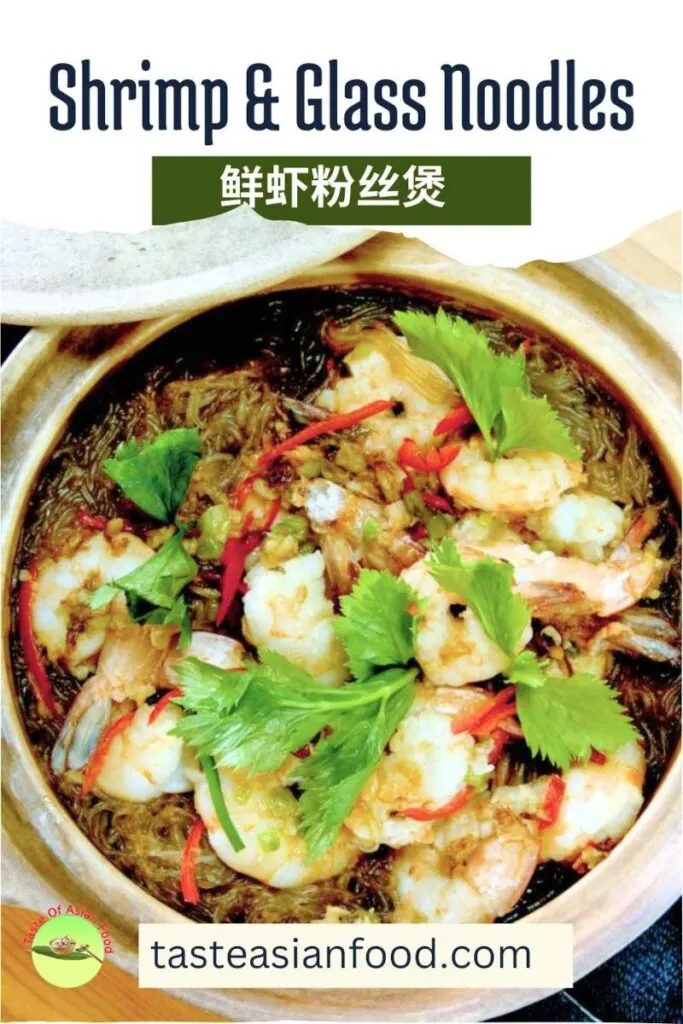
Ingredients required to make shrimp and glass noodles
- Shrimp: I choose medium to large shrimp. While frozen shrimp can be used, I use fresh shrimp from the wet market because it tastes much better.
- Glass Noodles: Glass noodles, also known as cellophane noodles and vermicelli bean threads, have a unique texture due to their transparent appearance. They remain transparent after cooking and are very springy and slippery. The most distinctive feature is their ability to absorb flavors like a sponge, making them an excellent medium for incorporating various tastes into the dish.
- Garlic, Ginger, Green Onions, and Red Chili: These four ingredients make this dish fragrant and aromatic. If you prefer a milder flavor, you can omit the chili and use it only as a garnish. Coriander roots are another ingredient commonly used in Thai shrimp glass noodles.
- Seasoning: Cantonese cuisine has straightforward seasonings. They typically include oyster sauce, light soy sauce, rice wine, and ground white pepper. Salt and sugar can be added to adjust the flavor, and dark soy sauce is optional if you want to darken the dish’s color slightly. Other seasonings you can add to the list are sesame oil, black pepper, and fish sauce.

How to prepare shrimp and glass noodles
1. Soak the glass noodles in water for 20 minutes. Drain the water and cut the noodles into shorter lengths with scissors.
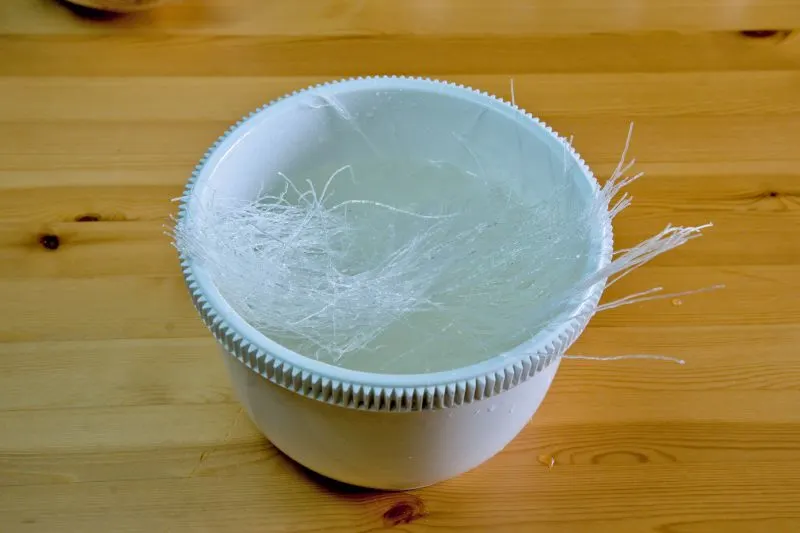
2. Remove the shrimp’s head and shell, then devein them. Pat dry with a paper towel. Set aside the shells and heads for later use.
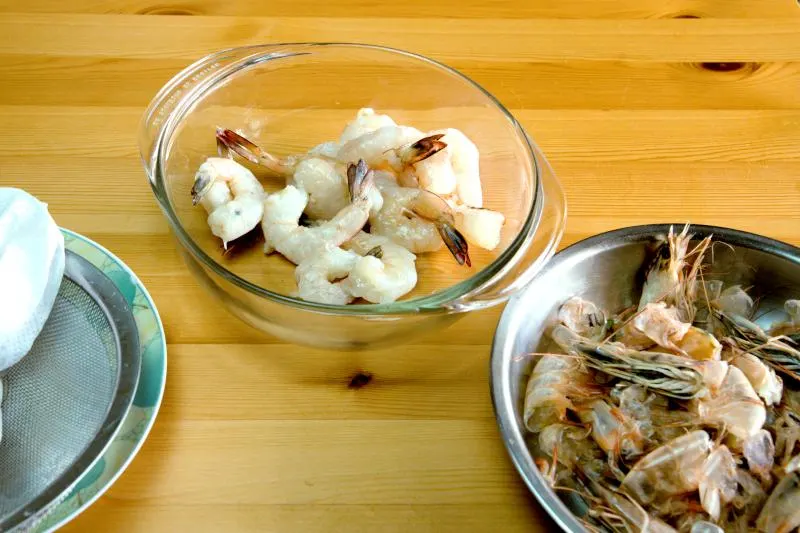
3. Heat oil in a pan or a large skillet, sauté the ginger, then garlic, green onion, and chili. Sauté for about half a minute or until fragrant.
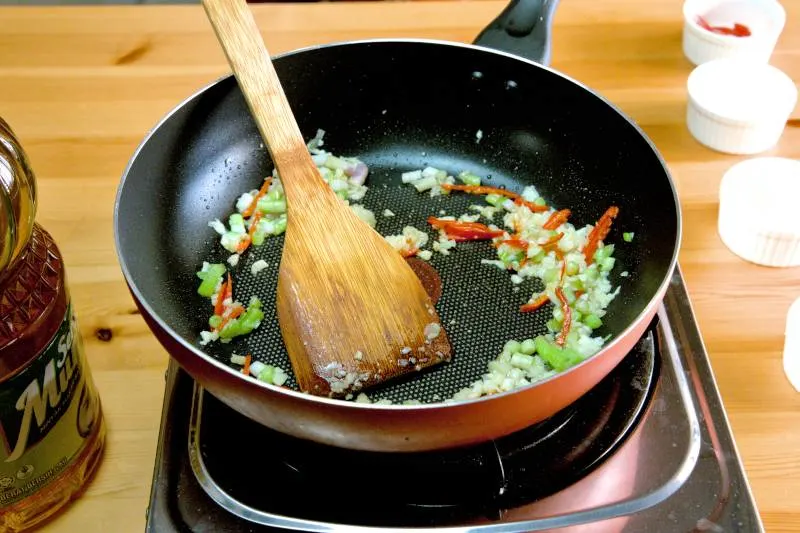
4. Add the shrimp to the pan and cook on both sides until they change color. Remove the shrimp and aromatics from the pan, keeping the remaining oil in the pan.
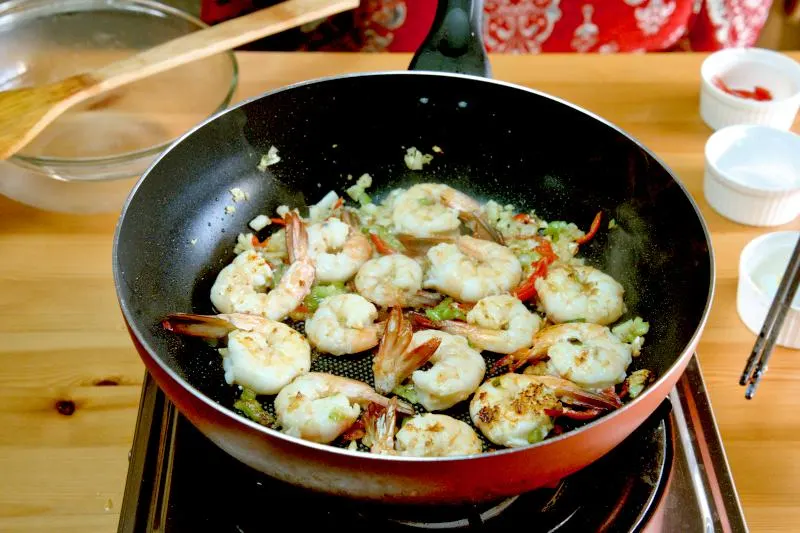
5. Add the shrimp shells and heads to the pan and fry over medium heat. If needed, add a little more oil. Press the shrimp heads with a spatula to release their flavor. Fry for a few minutes until you can smell a slightly smoky aroma.
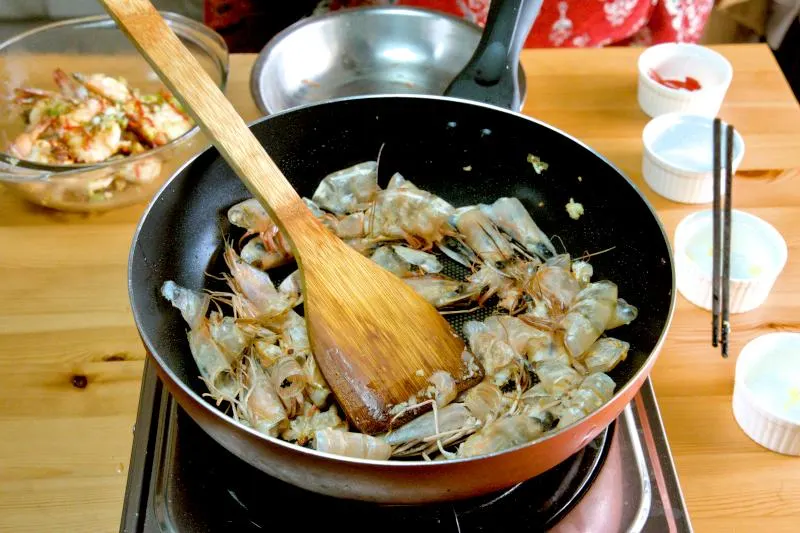
6. Add water to the pan and cook the shrimp shells and heads for two to three minutes. Strain the mixture to remove the shells and heads for the clean shrimp broth. Pour the strained shrimp broth into a clay pot. Season with salt, ground white pepper, oyster sauce, light soy sauce, dark soy sauce, and rice wine.
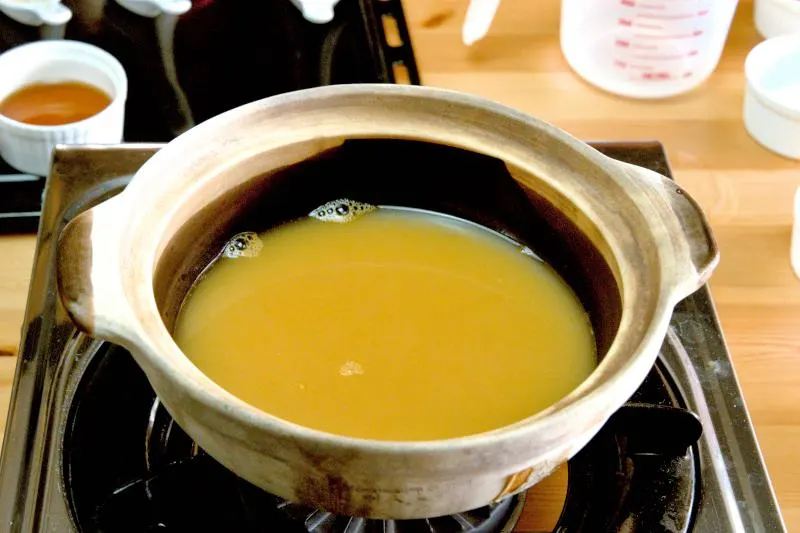
7. Add the glass noodles to the shrimp broth and let it simmer for one minute.
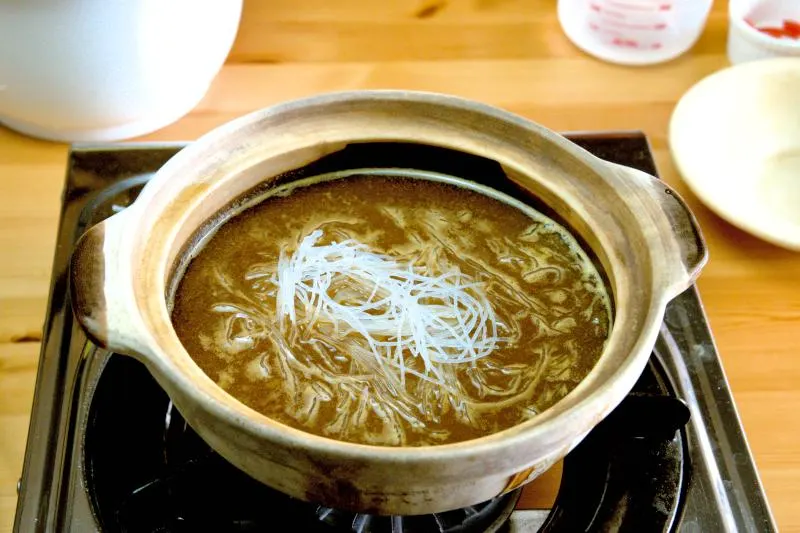
8. Return the shrimp to the clay pot and cook with the lid ajar for another minute. Garnish with coriander leaves to serve.
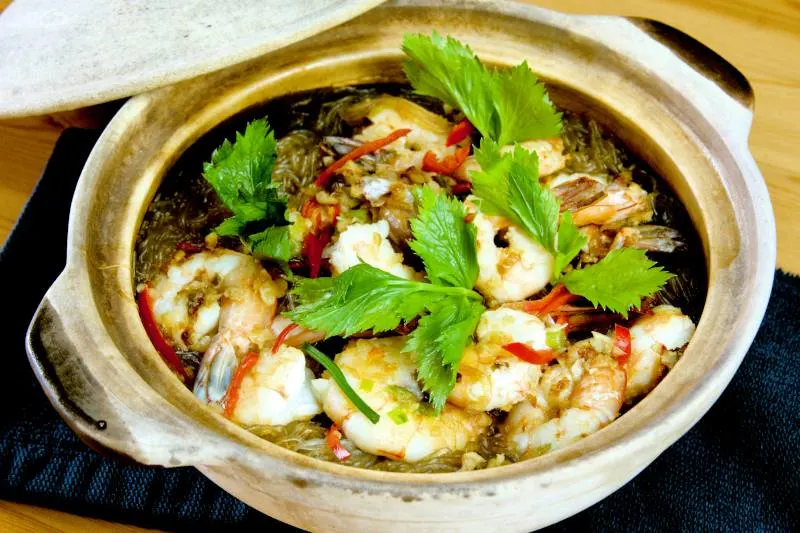
Note: This dish is also a popular Thai cuisine, where it is called กุ้งอบวุ้นเส้น (Goong Ob Woonsen). The preparation method is quite similar to the Chinese version.
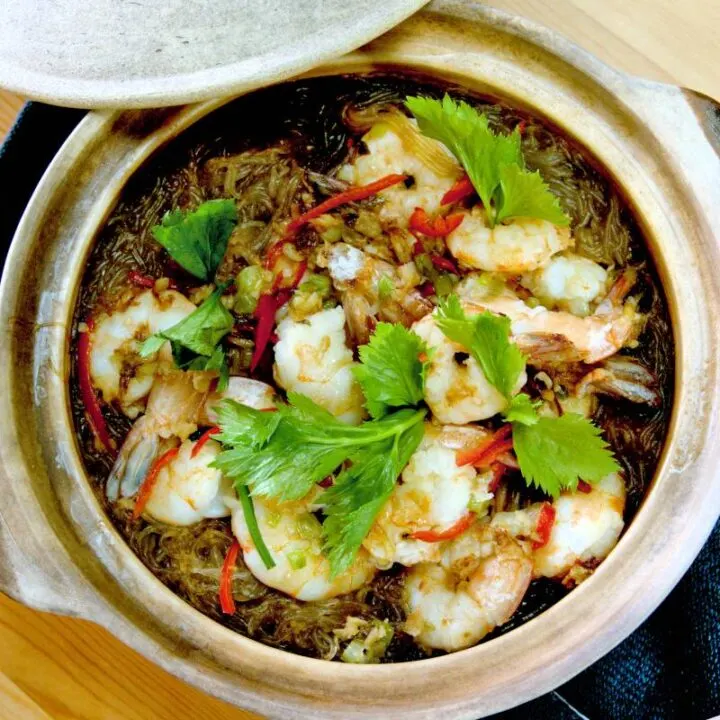
Shrimp and glass noodles in clay pot
Shrimp and glass noodles in a clay pot made with broth derived from the head and shell. The glass noodles absorb the broth's flavor and are very delicious.
Ingredients
Ingredients A
- 16 medium size shrimp
- 130g Glass noodles
- 1 tbsp chopped garlic
- 1 tbsp chopped ginger
- 1 tbsp chopped green onions (white section)
- 1 large red chili, cut into thin slices
- Coriander leaves and green onions to garnish
- 3 tbsp Cooking oil
Ingredients B
- 1/4 tsp salt
- 1/4 tsp ground white pepper
- 1/4 tsp salt
- 1 tsp sugar
- 2 tbsp oyster sauce
- 2 tbsp light soy sauce
- Dark soy sauce (optional)
- 2 tbsp rice wine
- 2 cups water
Instructions
- Soak the glass noodles in water for 20 minutes. Drain the water and cut the noodles into shorter lengths with scissors.
- Remove the shrimp's head and shell, then devein them. Pat dry with a paper towel. Set aside the shells and heads for later use.
- Heat oil in a pan and sauté the ginger, then garlic, green onion, and chili. Sauté for about half a minute or until fragrant.
- Add the shrimp to the pan and cook on both sides until they change color.
- Remove the shrimp and aromatics from the pan, keeping the remaining oil in the pan.
- Add the shrimp shells and heads to the pan and fry over medium heat. If needed, add a little more oil. Press the shrimp heads with a spatula to release their flavor. Fry for a few minutes until you can smell a slightly smoky aroma.
- Add water to the pan and cook the shrimp shells and heads for two to three minutes. Strain the mixture to remove the shells and heads to obtain the clean shrimp broth.
- Pour the strained shrimp broth into a clay pot. Season with salt, ground white pepper, oyster sauce, light soy sauce, dark soy sauce, and rice wine.
- Add the glass noodles to the shrimp broth and let it simmer for one minute.
- Return the shrimp to the clay pot and cook with the lid ajar for another minute. Garnish with coriander leaves to serve.
Recommended Products
As an Amazon Associate and member of other affiliate programs, I earn from qualifying purchases.
Nutrition Information:
Yield: 3 Serving Size: 1Amount Per Serving: Calories: 273Total Fat: 15gSaturated Fat: 1gTrans Fat: 0gUnsaturated Fat: 13gCholesterol: 56mgSodium: 1998mgCarbohydrates: 21gFiber: 2gSugar: 3gProtein: 11g
his data was provided and calculated by Nutritionix on 11/11/2024
Tips to make the perfect clay pot shrimp and glass noodles
- Glass noodles, also known as cellophane noodles in English and as 冬粉 in Chinese. In Malaysia, they are translated as Soo Hoon. If you’re uncertain about the names and want to ensure you’re purchasing the correct ingredients, showing the shop owner the two Chinese characters 冬粉 can be helpful. These noodles are commonly used in Chinese and Thai cuisines and are typically found in most Asian grocery stores.
- To prepare glass noodles, you can soak them in cold water to rehydrate. If you’re short of time, use warm water to speed up the process. Generally, they take 10 to 20 minutes to soften, and you can leave them a little longer without significantly affecting their texture.
- The most important part of this recipe is making the shrimp broth using the heads and shells of the shrimp. While some people discard the shrimp heads and shells, doing so diminishes the flavor. Some chefs prefer to keep the shells for a better presentation, but I prefer to remove them for a more enjoyable dining experience. (If you do not want the hassle of making shrimp stock, use store-bought chicken stock instead, but the flavor will not be as good.)
- For flavor, sauté the garlic, ginger, white part of the green onion, and red chilies until fragrant before adding other ingredients.
- I like to pan-fry the shrimp before adding it to the broth, as it adds a depth of flavor. I don’t season the shrimp during pan-frying because they will absorb flavors while cooking with the broth and glass noodles later.
- When frying the shrimp heads and shells, use medium heat and some oil until they release an aroma filling the kitchen. The heat should be moderately high, and you may even notice some smoke from the pan. This smoky flavor adds depth to the entire dish.
- Remember that glass noodles absorb shrimp broth quickly, so I typically use about two cups of water to make the broth. After cooking the noodles for about one to two minutes, you will notice that most of the broth has been absorbed. You should add more water if it becomes too dry.
- I usually add the pan-fried shrimp to the noodles and cook for another minute or two. This allows the shrimp to absorb as much flavor as possible from the broth.
- Lastly, while a clay pot is traditionally used for the final cooking stage and serving in Chinese restaurants, you can prepare this dish using any cooking utensil.
How to store the leftovers
I recommend consuming the shrimp and glass noodles clay pot on the same day. The glass noodles will continue to absorb the broth, becoming very soggy over time. Besides, shrimp, like any other seafood, should be as fresh as possible.
About glass noodles
Glass noodles, also known as cellophane noodles, fensi, mung bean noodles, bean thread noodles, and Soon Hoon, are a type of noodle made from starch derived from various sources, including mung beans, sweet potatoes, and tapioca. The variety I use is made from mung bean starch. Before cooking, these noodles are very brittle, long, thin, and white. When cooked, they become translucent, which is how they earned the name “glass noodles.” They have a smooth and slippery texture, are springy, and can absorb a lot of flavor and liquid during cooking. Please do not confuse glass noodles with rice noodles. The main difference is that rice noodles appear white after cooking, while glass noodles are transparent.
Other related Asian cuisines
If you enjoy this glass noodle and shrimp recipe, here are some additional related recipes I would like to suggest to you:
- Ipoh shredded chicken noodles (怡保河粉). The broth of this soup noodles is also made with shrimp shell and head, plus chicken bones.
- Pad See Ew. You will love this fried noodles dish, a popular Thai street food.
- Honey garlic shrimp. Quick and easy shrimp dish with a touch of Asian flavor.

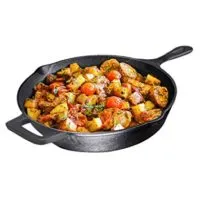

KP Kwan
Tuesday 12th of November 2024
Hi, this is KP Kwan. I am happy to see you in this comment area, as you have read through my recipe. I am glad to reply to any questions and comments as soon as possible.